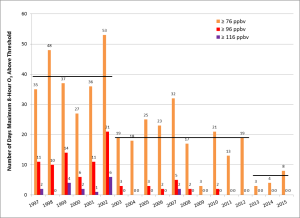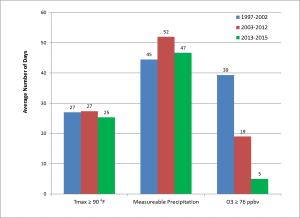Medium Range Air Quality Outlook
Mid-Atlantic Region
Issued: Monday, May 23, 2016
Valid: May 24-28, 2016 (Tuesday-Saturday)
Summary:
After a very quiet first three weeks in May, the Mid-Atlantic will transition to a synoptic pattern that is favorable for USG ozone beginning on Wednesday. The chances for USG ozone are Slight on Tuesday as a closed low aloft spins northward into New England and keeps the weather unsettled. A broad but persistent upper level ridge will move eastward on Wednesday, settle overhead on Thursday, and then build westward on Friday; the Mid-Atlantic will remain on the western periphery of the ridge through at least the beginning of next week. Temperatures will rise into the upper 80s to low 90s °F across the region Wednesday through Saturday. Wednesday may be a transition day, with Marginal chances for USG ozone, mainly along and east of the I-95 Corridor and across NC, where skies will remain sunny through the entire afternoon. The main forecast question for the end of the period is the extent and location of precipitation, triggered by a series of shortwaves aloft interacting with a stationary frontal boundary draped across NY and New England. While chances for USG ozone rise to Appreciable for Thursday-Saturday, questions about the precipitation forecast keep substantial uncertainty in the air quality forecast. PM2.5 is expected to remain in the Good to low Moderate range through Wednesday, with concentrations increasing to the widespread low Moderate range through the end of the period in response to rising humidity.
Discussion:
The weather forecast models are in close agreement on the synoptic scale features through Thursday, but they diverge on Friday and Saturday. The 06Z NAM and GFS and 00Z ECMWF were consulted for this analysis. The period begins with a closed low aloft spinning along the Eastern Seaboard, moving from over VA today to eastern New England on Tuesday; the low exits to the northeast by Wednesday morning. At the same time, a broad upper level ridge roughly centered over the Great Lakes on Monday will build eastward over the Mid-Atlantic on Tuesday. The models are in excellent agreement on the placement of these features, giving us high confidence for the first part of the medium range period. The upper level ridge is in place over the Mid-Atlantic on Wednesday; this is a broad feature, not particularly amplified, with many small embedded shortwaves. The upper level ridge continues to gradually move eastward through the end of the period, with the axis located along the East Coast on Thursday. By Friday, the Mid-Atlantic is on the western periphery of the ridge. The GFS and EC diverge regarding the amplification of the ridge at the end of the period, related to the placement of a strong shortwave spinning up over the Northern Plains. The GFS amplifies the Mid-Atlantic ridge and moves the shortwave farther north, into the southern Canadian Prairies, while the EC keeps the northern edge of the ridge suppressed compared to the GFS and also has the shortwave farther south, in the Dakotas. WPC sides with the EC solution at this time.
At the surface, high pressure moves over the region on Tuesday, and off shore on Wednesday, hooking up with the Bermuda High beginning on Thursday. A weak back door cold front over MI/ON on Tuesday stalls along northern NY and New England on Wednesday. The front remains north of the Mid-Atlantic and oscillates over NY and New England through the end of the period. The numerous shortwaves embedded in the upper level flow around and in the ridge interact with the stalled frontal boundary and trigger widespread showers and thunderstorms during the end of the medium range period. This activity is supported by the 09Z SREF for Thursday. Given the questions regarding the placement of the upper level ridge on Friday and Saturday, there is considerable uncertainty regarding the extent and location of any precipitation at the end of the period, but it is reflected in both the GFS and EC solutions.
On Tuesday, a warming trend will begin, with temperatures reaching near average for this time of year. The closed low will be moving northward along the East Coast, keeping clouds, scattered showers, and possibly isolated thunderstorms in the forecast. As a result, the chances for USG ozone are Slight. The air quality models have isolated Moderate ozone along western PA and NC, which seems reasonable. Good to low Moderate PM2.5 is expected to continue until around Thursday, when humidity begins to rise.
Wednesday is one of the two key days of interest during this period. As the upper level ridge builds eastward, skies will be sunny for most of the region, and temperatures will jump well into the 80s °F. Surface winds will be westerly, with slow-ish northwesterly transport aloft. Widespread Moderate ozone is likely, with a Marginal chance for USG ozone. The exception will be along the western Mid-Atlantic, particularly western PA and NC, where clouds and afternoon showers will develop. The main forecast question will be how quickly the air mass modifies, with a more quickly modifying air mass translating into higher chances of USG ozone.
Thursday is also a day of interest, given the rising temperatures as the upper level ridge builds overhead and the Bermuda High extends westward. The main source of uncertainty is the precipitation forecast. As noted above, the weather forecast models, including the SREF, develop widespread afternoon showers, mainly west of I-95. As a result, the best chances for upper Moderate to USG ozone will be along and east of the I-95 Corridor, as well as across NC, with an Appreciable chance for USG ozone. The air quality models keep ozone in the upper Moderate range, with no pockets of USG ozone at this time.
Conditions on Friday and Saturday look to be generally similar to Thursday. Uncertainty remains in the chances for USG ozone, given the questions regarding the precipitation forecast. As noted above, both the EC and GFS trigger widespread afternoon showers and thunderstorms across most of the region. Identifying the exact location and extent of any convection will be the main forecast question for the end of the period. Given temperatures in the mid to upper 80s °F, and at least partly sunny skies, Appreciable chances for USG ozone will continue, with considerable uncertainty.
-Huff/Brown




